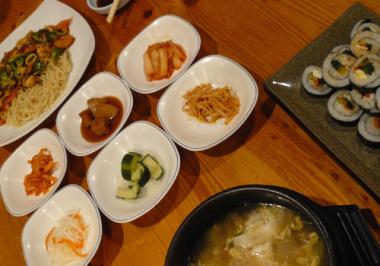Gohyang Korean Restaurant
111 Russell Street, Hadley
413-586-2682
Hours: Mon. 5 p.m.-9 p.m.
Tue.–Thu. 11:30 a.m.-9 p.m.
Fri.–Sat. 11:30 a.m.-10 p.m.
Sun. 12 p.m.–9 p.m.
Prices: $6.95 to $14.95.
You have to love a restaurant where the most expensive thing on the menu is grilled eel. Korean food is a thing unto itself. Those who think that ribs are all this Oriental cuisine has to offer should think again. At the simply named “Korean Restaurant” in Hadley, meals begin with an array of six sides that range from sweet to spicy to sour to strange. Kim chi, cabbage fermented underground in fish oil, has a long shelf life and promises the same for those who eat it. Kim chi is to Korean food as pasta is to Italian food. Koreans include it in every meal.
Known as “panchan,” the dishes that begin a Korean meal at this restaurant consist of pickled cucumbers (sweet and crisp with vinegar), potatoes in a brown sauce (sweet and unusual), fresh radish (refreshing), pickled radish (spicy in a bit of red sauce; beware of the red sauces, they are lethal), mung bean sprouts (slightly tangy and sour but refreshing), and the aforementioned Kim chi, which is very spicy, made with red pepper powder, which masked the life-enhancing fish taste of the fermentation. It’s an acquired taste and not half bad if you give it a chance.
In addition to the lively lineup of Panchan come appetizers, meat dishes, seafood dishes, rice dishes, soup and broth dishes and noodle dishes. The Koreans value family style-dining and the principle of the big bowl. Traditionally, sticky rice (not sticky rice, but moist Korean-style white rice) will accompany myriad ingredients served steaming in a black stone bowl. Variations on this theme can be had in such dishes as Mae Woon Tang, a spicy codfish soup with tofu, and Bok a Guk, dried pollack soup with oil, egg, garlic and onions. This one is funky in that the pollack is still pretty dry and bony as well. This soup is salty and hearty due to the fibrous quality of the dried fish, but the oil and garlic provide a lot of the flavor.
Gim Bap is 15 pieces of a sushi roll with egg, spinach, pickled radish and carrot. It is different than Japanese sushi in that there is no luscious fish to bite into, just this very healthy, salty, tangy and tasty veggie combination.
The final pick was the Hae Mul noodle dish brought by a lovely waitress who urged us to eat it instantly since the noodles were fresh. With fresh noodles, there is the danger of coagulation if too much time passes. Topped with slippery, glistening clams and shrimp with the tails on, this dish was very assertive and somewhat heavy. This is great, fortifying food that ends the day well and provides the gusto for soldiering on through the evening. Lunch specials for just over $5 consist of a combination dish with fried rice or Chapchae, a vermicelli dish, dumplings and a choice of beef, chicken, pork, squid, vegetable or tofu.
Tea is served throughout the meal. It is corn tea and has no caffeine. There is no liquor license at Korean Restaurant, although bringing a bottle or two in is allowed. I recommend beer from any culture, and lots of it! Ultimately, the best way to eat Korean is with an open mind and a desire to have a longer life.



